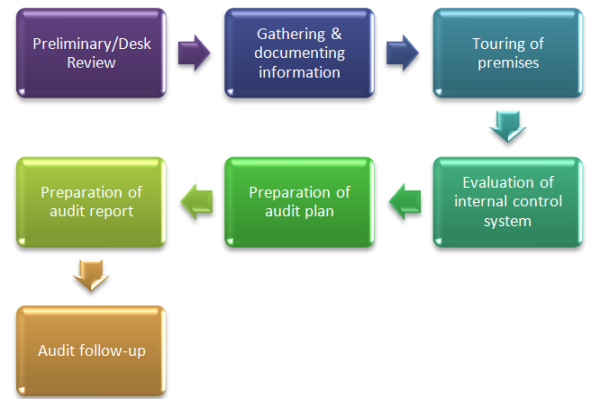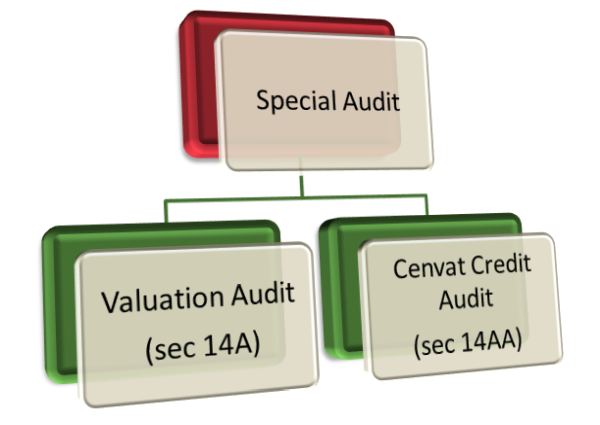Goods are removed by the assessee under self-removal system (except in case of cigarettes). Further, Excise department do not verify the returns filed by the assessee and hence there is a need for audit of assessee to ensure that there are no revenue leakages thereby protecting the interest of the government.
Types of Audit

Central Excise Revenue Audit (CERA)
a. It is an audit of Central Excise (CE) department’s functioning and it is carried out at the office of CE department by CAG of India.
b. It focuses on ascertaining revenue leakage & is assessed on the basis of periodical returns filed by the assessee, execution of various bonds & other information such as cost audit reports, income tax audit reports etc.
c. CERA auditor has right to visit office of assessee even though it is not an audit of assessee.
d. No defined frequency for carrying out audit.
e. CAG submits report to President of India, who causes it to be laid before each House of Parliament.
Central Excise Audit 2000 (Internal Audit)
a. It is an audit of assessee which is conducted by CE department officials.
b. Selection of assessee is based on risk factors like bad track record etc.
c. A minimum of 15 days notice should be given to the assessee before commencing the audit.
Frequency of audit
|
Excise duty payment (annual) |
Frequency |
Duration |
|
≤ 50 lacs |
10% of units |
5 days |
|
> 50 ≤ 100 lacs |
Once in 5 yrs |
5 days |
|
> 100 ≤ 300 lacs |
Once in 2 yrs |
7 days |
|
> 300 lacs |
Yearly |
10 days |
About 25% of Export Oriented Units will be audited every year.
Process Involved

Preliminary or Desk Review
a. It is carried out by a practicing Cost/Chartered Accountant without interacting with the assessee & hence it is called desk review.
b. It is carried out at the office of CE department.
c. It is a part of internal audit procedure and services of professionals are taken to help the department.
d. Scope is to ascertain evasion of duty, undervaluation of excisable goods, cenvat credit misuse, execution of bonds & its misuse, evasion of interest/penalty (if any), facts produced by assessee is in order or not etc.
e. It helps CE department to assess risk of assessee & prepare a suitable audit plan.
f. Audit team collects data/records for preliminary review such as information about assessee, its operations, reason for selection of unit, possible issues that can be identified at the present stage, assessee profile, annual report, cost audit report, tax audit report etc.
g. The audit should be completed in 5-7 working days.
Gathering & Documenting Assessee Information
With the help of desk review, CE auditors identify certain areas, which need closer examination. Department may write to the assessee or send questionnaire to obtain necessary information.
Touring of Premises
The auditor visits factory & gathers information about production process, marketing process, system of accounting, inventory management and verifies duty payment details, existence of physical stock & correctness of stock records etc.
Evaluation of Internal Control System
Evaluation of internal control system is necessary in order to determine the scope and extent of audit checks required for the selected assessee. It is done by walking through a transaction from beginning to end.
Preparation of Audit Plan
a. It should include information about complexity of unit, materiality, problems & risk factors identified up to the present point & reason for selection of unit for audit.
b. Audit should be taken up only after the draft audit plan is approved by Additional or Joint Commissioner (Audit).
c. Auditor should stick to the approved plan in conducting audit.
Preparation of Audit Report
a. It is putting together all the audit findings in one place.
b. Where necessary, important objections and findings must be reviewed with the immediate supervisor before discussing the same with the assessee.
c. Auditor should inform assessee of all objections before preparing draft audit report.
d. The assessee must have opportunity to offer clarifications with supporting documents to avoid unnecessary disputes.
Audit follow-up
a. After submission of report with working papers, the Superintendent in charge of audit should discuss major points with Assistant/Deputy Commissioner (Audit).
b. Report should be submitted for evaluation to Audit Monitoring Cell, headed by the Commissioner.
c. The Cell during its monthly meetings should review the reports for final acceptance (or non-acceptance) of audit points, after which the draft audit report would be finalized.
d. Audit cell should update the assessee master file based on the audit report.
Special Audit
 Valuation Audit (sec 14A of Central Excise Act)
Valuation Audit (sec 14A of Central Excise Act)
a. Duty payment is said to be correct only when the valuation is correct and hence valuation is critical.
b. During any stage of enquiry, investigation or other proceedings before any CE officer (not below the rank of Assistant/Deputy Commissioner) having regard to the nature and complexity of case and the interest of revenue, is of opinion that the value has not been correctly declared/determined by the manufacturer, s/he with the prior approval of the Principal Chief Commissioner/Chief Commissioner of Central Excise can order valuation of assessable value.
c. Audit will be conducted by a qualified Cost/Chartered Accountant nominated by the Chief Commissioner.
d. Audit can be ordered notwithstanding that the accounts of manufacturer have been audited under any law for the time being in force or otherwise.
e. Maximum time limit to submit audit report is 180 days from the date of receipt of cost audit order by the manufacturer.
f. Expenses & audit fees shall be paid by excise department to cost auditor.
g. Auditor is required to find:
- Whether assessable value of goods manufactured is correct,
- Whether classification of goods is correct,
- Whether certification is required & such certification has been obtained,
- Whether cost of production shown in cost sheet is in accordance with CAS4 issued by the Institute of Cost Accountants of India,
- Whether raw material shown in purchase book matches with purchase invoice.
Cenvat Credit Audit (sec 14AA of Central Excise Act)
a. It Principal Commissioner/Commissioner of Central Excise has reason to believe that the credit/utilization of duty by the manufacturer is not within normal limits having regard to nature of goods produced, types of inputs used etc or credit has been availed/utilized by reason of fraud/collusion/wilful misstatement, s/he may direct to get the accounts of factory audited by a Cost/Chartered Accountant nominated by her/him.
b. The Cost/Chartered Accountant has to submit the report within time specified by the Commissioner.
c. Audit can be ordered notwithstanding that the accounts of manufacturer have been audited under any other law for the time being in force or otherwise.






 CAclubindia
CAclubindia

